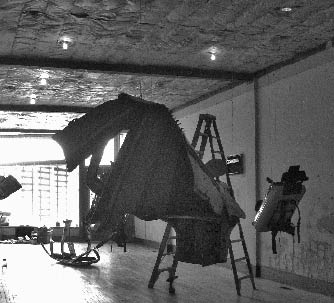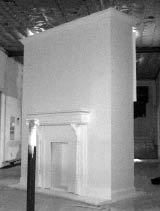Temporarily Gallery 1716
by Albert Chao

On Friday, March 30, Frank Fantauzzi, associate professor of architecture at the University at Buffalo, will host exhibits by two UB MFA artists, Penelope Stewart and Elinor Whidden, in his ongoing renovation project at 1716 Main Street. During the period of the exhibition, the space will be temporarily named Gallery 1716.
In Portage: Ford Taurus, Elinor Whidden suspends both time and space with floating sculptural assemblages of reconfigured car parts. The installation, though chaotic, yearns quietly for a return to the sublime.
A video projection details a voyage to Niagara Falls. In a past summer, Whidden reenacted the 1678 portage path of explorer Robert Rene de la Salle and Father Louis Hennepin in their travels by the water routes, or “voyageurs highways,” of the Great Lakes, which led them to Niagara Falls. Whidden, in her passage, carries remnants of a 1995 Ford Taurus that are reconfigured into the elements of a canoe trip: canoes, paddles, packs and dogsled. The pieces, suspended at a level that relates to the body, allow viewers to physically step in and carry the load. In a reversal of roles, passengers carry vehicle. The car reaches the outskirts of Niagara Falls, a symbol of the sublime, by means of the body. The Ford Taurus is transformed into “useful” parts that are necessary for travel.
Portage: Ford Taurus alludes to a transformed landscape. Ford, the symbol of the utopian desire to put “a car in every driveway,” created a new form of travel: The open terrain of nature and wilderness is now endless roads and highways. Progress is measured by the reaches of these roadways. However, this newly configured terrain presents a duality within travel: The forms for travel and freedom, including roads, highways and cars, can also be elements of confinement, i.e. cars breaking down, road failures, etc. Whidden engages and resists these confinements in the burdensome act of carrying the various assemblages of the Ford Taurus on her back.
Penelope Stewart presents a different sense of an ideal in A Study of Duration. In her sculptural installations, she subtly subverts images of the 17th-century home by carefully pulling apart the delicate fabric hanging between the ideal and the real.
An elegant, enormous, 19th-century Victorian fireplace stands juxtaposed against the raw, unfinished walls of the space. The style, though in some ways outmoded, embodies a particular Western ideal of comfort, warmth and family. However, upon closer inspection, one sees and smells a layer of beeswax that seals the utopian ideal of family. The beeswax, during the exhibition, will slowly melt away. A mirror on the mantel creates an illusion of another space that further places the viewer within the work. The fire mantel dissolves from a romanticized image of the home to an unsettling, disturbing experience. Also, the false nature of the fireplace produces a feeling of loss at an unattainable ideal.

Stewart also recreates the dualities of the idealized home in her perspective boxes. In these, the enormity of her fireplace is mimicked in a miniature model reminiscent of a trompe l’oeil painting. The effect is similar to that of the fireplace, where one looks into a viewfinder at an idealized version of the home. Stewart describes her work as an exploration of 20th-century French philosopher Michel Foucault’s “heterotopic” spaces. These spaces are a simultaneous relationship between real and ideal, which then challenge former utopian constructions.
Futility is exemplified by another piece consisting of thousands of beeswax casted doorknobs. These are placed site-specifically along the back wall, where two doors sit approximately three feet high with no stairway leading up to them. This juxtaposition heightens the irreconcilable differences between individual and environment and thus creates a sense of anxiety and loss.
This exhibition featuring both Stewart and Whidden is an essential part of Fantauzzi’s renovations of 1716 Main Street. Fantauzzi has been investing time, energy and money into rehabilitating the dilapidated building. The building, a former industrial factory, has been divided into three main parts. The second floor of the space was recreated into an open, 4,200-square-foot loft—an exciting living space, to be sure, but rivaled in potential by the other spaces. The exhibition space is capable of housing large-scale installations, as demonstrated by Whidden and Stewart. Part of the wood for the floor was salvaged from other parts of the building, while the rest is stripped-down plywood. The walls are raw and unfinished at the request of the artists, who requested the walls be left untouched until after the exhibition.
An in-house workshop, equipped with wood- and metal-working machines, allows freedom and flexibility when working on projects. The two artists completed much of their work on-site. In addition, most of the renovation process was done in-house. This creates a unique live/work space on a very large scale. Fantauzzi, an avid proponent of hands-on work, has created a haven for fabrication and building.
Fantauzzi’s space is one of several successful renovations of abandoned industrial buildings along Main Street, including the Tri-Main Center and the upcoming Artspace project, the Sarabeth Artists Lofts, currently under construction. Fantauzzi has laid the basic elements for a space that is functional and open for a wide array of future possibilities.
There will be an opening reception Friday, March 30, 8pm-midnight. The exhibits can be veiwed by appointment (juryrigged@gmail.com) through April 7.
Joan Ockman is
2007 Clarkson Chair
Joan Ockman is the 2007 Clarkson Chair in Architecture for the University at Buffalo School of Architecture and Planning.
Ockman has been an avid contributor to contemporary architectural criticism and writing. She has recently edited the volume Out of Ground Zero: Case Studies in Urban Reinvention in 2002. In 2000, she co-organized the conference “Things in the Making: Contemporary Architecture and the Pragmatist Imagination” at the Museum of Modern Art in New York with Terence Riley, and edited The Pragmatist Imagination: Thinking About “Things in the Making”. She has also contributed essays and reviews to an extensive array of published periodicals and books.
She currently is director of the Temple Hoyne Buell Center for Study of American Architecture at Columbia University’s Graduate School of Architecture, Planning and Preservation and has been teaching history and theory classes since 1985. Ockman will be in residence during the week of April 2 with a public lecture on Wednesday, April 4 at 5:30pm in 147 Diefendorf Hall on South Campus.
Design Matters is presented in association with the UB School of Architecture and Planning and supported by a fellowship endowed by Polis Realty.
|
Issue Navigation> Issue Index > v6n13: The Trials of Ralph Hernandez (3/29/07) > Temporarily Gallery 1716 This Week's Issue • Artvoice Daily • Artvoice TV • Events Calendar • Classifieds |









 Current Issue
Current Issue